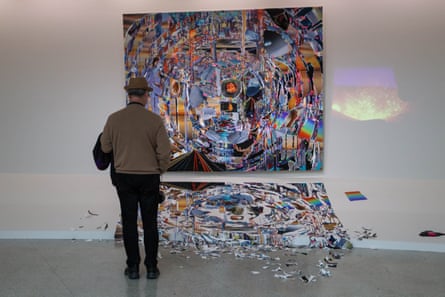In 1972, John Berger’s revelatory TV series and subsequent book, Ways of Seeing, began by discussing the changing ways we experience art via the then recent innovation of colour televisions in homes. Berger argued that “we see these paintings as nobody saw them before … Your wallpaper is around them, your window is opposite them, your carpet is below them. You are seeing them in the context of your own life.”
More than 50 years on, as smartphone users, we are able to access unlimited artworks in a moment. As Berger pointed out, “an image that is reproduced can be seen in a million different places at the same time”, so how can we take in the sheer amount of information available for consumption today?
All artists react to the time in which they live. But, for me, it is the US-based Sarah Sze who acutely translates the abundance of images into visual form. Through her planetarium-like structures, ecosystems built from everyday objects (often made from the same objects used to build the structure we are looking at – ladders, wires, scissors), or kaleidoscopic worlds with projections of moving images, she gives us a glimpse into the proliferation of information we experience daily.
Meticulously arranged, yet compiled of structures that appear to be blitzed and shattered, Sze’s works are essentially a collage: of painting, sculpture and architecture, as well as the adverts we are constantly fed, the components that make up our screens. (In her book of essays, Feel Free, Zadie Smith discusses how, upon a visit to Sze’s studio, her children likened the works to a “sort of exploded iPhone’’.) But Sze also includes everyday objects (plants, clocks, chairs, screens), projected videos of nature (water, fire, earth), and traditional art materials (paints, prints, photographs), as if to challenge the very notion of what art can be.
Sze’s structures – precariously held together by sticks, as if pertaining to the fragility of life – relinquish all artistic convention. Without a clear indication of where a work begins and ends, as we circumnavigate them, our perspective constantly changes as the works are near impossible to take in all at once. I liken them to Manhattan: we can see it whole from afar, but when you’re actually in it, our viewpoint changes by the second.
I’ve visited Sze’s current exhibition, Timelapse, at the Guggenheim in New York three times now. With each visit, I have seen new images, projections, structures and tools. When I’m first struck with her works I can be overwhelmed, but as I walk around and through them, they allow me to realise that images in our lives are constantly in flux. Even the screen I am typing on is changing at a rapid pace with the more letters I add or take away, or the notifications that ping.
The composer Philip Glass said that, to him, music is like “an underground river – it’s always there … You don’t know where it comes from and you don’t know where it’s going. The only difference is whether you are listening to it or not.” Sze’s sculptures, too, maintain their frenetic presence whether we’re looking at them or not. Time is built into the experience – we suddenly notice a projection of a bird flying on a wall next to us; the sound of white noise.
They push the viewer to re-evaluate our physical, emotional or sensorial experiences with art and the world at large by making us realise memory is manipulated through images. Today we constantly document life through our smartphones, meaning that Sze (born in 1969), myself (1994), and someone born in the last few years, will each have a very different understanding of our lives through photographs.
after newsletter promotion
Since early 2021, I’ve meticulously kept a diary to try to capture memories, experiences and emotions. I also do this when I’m standing in front of art: downloading everything I see, how the work made me feel – otherwise it will be forgotten. Unsurprisingly, these artworks are the ones I retain a much greater understanding of, as opposed to those I have merely snapped on my iPhone. This also makes me question how many works of art we are experiencing through this 3×6 inch portrait created by our phones? How many people at the Louvre are looking at Leonardo da Vinci’s Mona Lisa through their screens?
Berger states that “original paintings are still unique … they look different from how they look on the television screen or on postcards … reproductions distort”. Through her laboratory-like worlds of shattered imagery, Sze allows me to attempt to understand how we are consuming images. But it also makes me question, through the abundance of technology, whether we are losing the sensory experience of viewing art, or being in the world at large.

